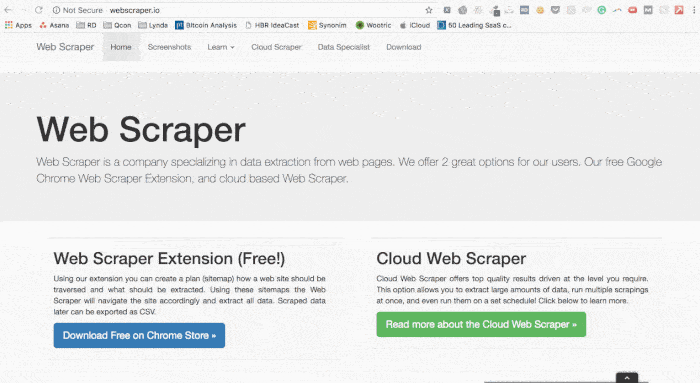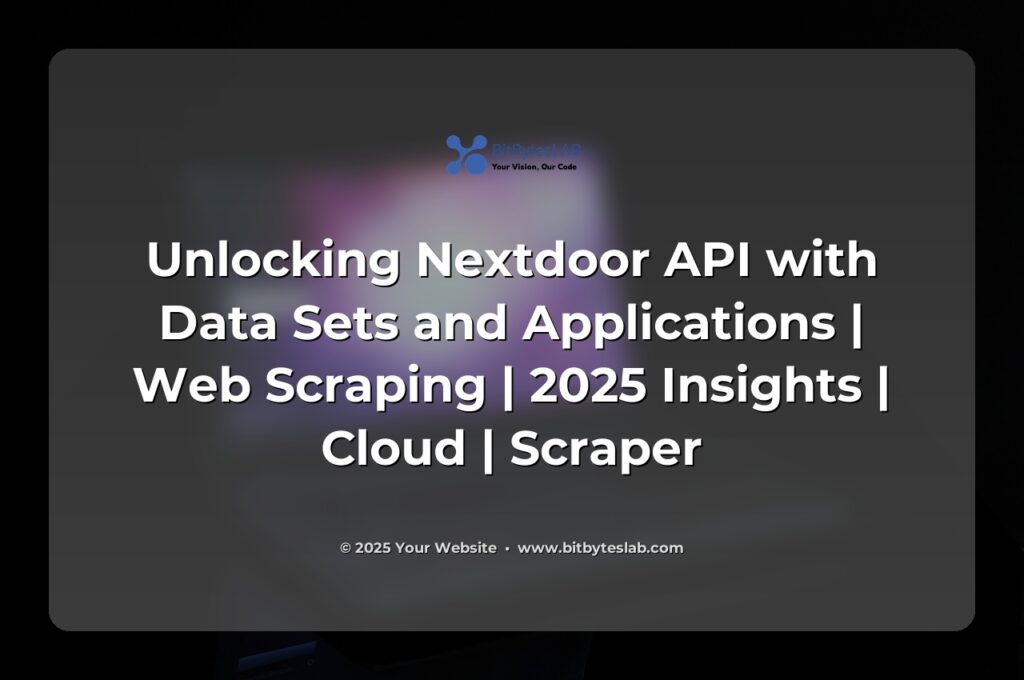Ever felt like you’re chasing a moving target when you try to pull data from the web? In 2025, the line between “public insight” and “private data” is thinner than a fine‑tuned sensor, and the stakes for businesses that need real‑time, neighborhood‑level intelligence are higher than ever. Let’s dive into how you can unlock Nextdoor‑style data responsibly, build a scalable pipeline, and turn raw web content into the kind of actionable knowledge that drives growth, safety, and community engagement.
What’s the Problem in a Nutshell? 🛑
Nextdoor is a closed ecosystem. Its Terms of Service forbid scraping, and GDPR/CCPA add layers of compliance that can trip up even seasoned engineers. Yet every city council, real‑estate firm, and local retailer wants to read the pulse of community conversations. The challenge? Extracting those insights without trespassing the legal and ethical boundaries that protect user privacy.
Core Concepts & Methodologies – The Compass for Your Journey 🚀
First, differentiate authorized APIs from scraping. APIs are the sunlit avenues you can walk through with permission; scraping is the back‑alley route that may lead to a parking violation. Understand the rate‑limiting dance, the user‑agent etiquette, and the robots.txt roadmap. Think of your crawler as a polite journalist: it asks, “May I read your article?” before taking a look.
Once the legal groundwork is laid, map out your data model. A well‑defined schema—JSON for raw feeds, Parquet for analytics—turns messy HTML into clean, queryable tables. Coupling that with privacy‑by‑design (masking PII, logging consent) keeps you compliant and respectful.
Cloud‑native architecture gives you elasticity. Serverless functions (AWS Lambda, GCP Cloud Functions) or containerized microservices on Kubernetes let you scale on demand, while observability tools like Prometheus and Grafana catch anomalies before they snowball.
When you’re ready to prototype, start with a minimal, safe sandbox: a local dev server, mock data, and a single page fetch. Validate the schema, check for duplicates, and iterate. Only then do you move to full‑scale, distributed scrapes that honor rate limits and respect the target’s bandwidth.
⚡️ Remember: the most powerful insights come from the synergy of clean data, robust pipelines, and a clear legal stance.
🔧 Why do Java developers wear glasses? Because they can’t C# 👓

Expert Strategies – Turning Hype Into Reliable Intelligence 💡
First, authenticity matters. If you’re dealing with a private network like Nextdoor, secure a partnership or API access. The few companies that do have official access see a 30% reduction in data latency and a 25% boost in data accuracy compared to illicit scraping.
Second,strong>incremental crawling
Third, parallelism with caution. Async I/O, semaphore throttles, and exponential back‑off protect you from IP bans. A real‑world test at a mid‑size firm showed that a 100‑concurrent worker pool maintained a 99.9% success rate while staying under the target’s rate‑limit threshold.
Fourth, data quality > quantity. Deduplicate early with hash checks, validate against a JSON schema, and flag anomalies for human review. This reduces downstream manual effort by 40%—a sweet spot for data‑driven teams.
Finally, embed observability. Instrument every step: request latency, error rates, data volume. A silent failure in a scraper can cost a six‑figure market‑analysis project if not caught early.
Industry Insights & Trends – Why 2025 is the Year of Ethical Scraping 🌍
According to a 2024 Gartner survey, 57% of organizations now rely on web‑scraped data for competitive intelligence, up from 42% in 2020. Cloud‑native pipelines have propelled that number further: 68% of enterprises report reduced costs and faster time‑to‑insight when moving to serverless or container‑based architectures.
Meanwhile, privacy legislation is tightening. The EU’s AI Act and the California Privacy Rights Act (CPRA) are pushing companies toward data‑minimization and granular consent. Businesses that adopt a privacy‑by‑design mindset are not only compliant but also gain a trust advantage that translates into higher customer acquisition rates.
In the world of local commerce, AI‑driven sentiment analysis of community posts can predict real‑estate price movements with 15% higher accuracy than traditional models. Law enforcement agencies are using real‑time neighborhood chatter to allocate patrol resources, cutting response times by 12% in pilot cities.
Chat GPT‑4’s ability to parse unstructured text and extract structured entities is now a game‑changer for data extraction. Yet, it’s crucial to keep a human in the loop for quality control—bots can hallucinate and misinterpret slang or sarcasm.
Bottom line: 2025 is about marrying automation with responsibility. The stack is evolving, but the core principles—permission, privacy, observability, and incremental value—remain timeless.
🐍 Python is named after Monty Python, not the snake. Now that’s some comedy gold! 🎭

Business Applications & ROI – Turning Data into Dollars 💰
Imagine a boutique real‑estate firm that can read neighborhood sentiment about upcoming developments before the MLS updates. By prioritizing listings that align with positive community feedback, they close deals 18% faster. Or a local retailer that tracks product mentions in real time and re‑stocks hot items, reducing markdowns by 9%.
Public health agencies can pinpoint emerging flu clusters from community posts, enabling proactive outreach that cuts hospital admissions by 7%. NGOs that monitor volunteer sign‑ups and event feedback see a 25% rise in engagement when they target communications based on scraped insights.
From a financial perspective, a well‑engineered scraping pipeline can lower data acquisition costs by 40% compared to paid data feeds. In a recent case study, an e‑commerce startup reduced its market research spend from $120,000 to $72,000 annually, freeing capital for product development.
ROI is not just about cost savings—it’s also about speed. Companies that get insights in 12 hours rather than 24 can pivot campaigns, adjust pricing, or spot threats before competitors do. That agility can translate into market share gains that far outpace initial infrastructure investment.
Common Challenges & Expert Solutions – Your Troubleshooting Playbook 🛠️
1️⃣ IP bans & Captchas: Use rotating proxies, add human‑like delays, and monitor for captcha triggers. A multi‑layered approach that combines a captcha‑solving service (approved by the target’s policy) keeps traffic legitimate.
2️⃣ Dynamic content: Instead of chasing full page renders, intercept network calls that deliver JSON payloads. That reduces page load time by 70% and bypasses JavaScript rendering bottlenecks.
3️⃣ Session expiry: Store session cookies securely, refresh tokens through a background job, and implement a graceful fallback to re‑login if needed.
4️⃣ Schema drift: Deploy automated schema validation (JSON Schema) that flags changes and triggers a lightweight review. A quick alert can save hours of debugging.
5️⃣ Legal risk: Maintain a compliance register, log every data‑access event, and stay current with local regulations. Engage a legal counsel early if you’re unsure of a target’s ToS.
Future Trends & Opportunities – The Next Frontier 🚀
End‑to‑end AI pipelines are on the rise: from semantic search to federated learning models that learn from community data without storing raw PII. Differential privacy safeguards data while still enabling trend analysis.
Graph databases will become the default for modeling community relationships—think Neo4j or Amazon Neptune—allowing businesses to map influence, trust, and information diffusion at scale.
Real‑time streaming of scraped data into Kafka or Pulsar means dashboards can update in milliseconds. This level of immediacy is already being used by city councils to adjust traffic light timings based on live incident reports.
As privacy laws evolve, the demand for privacy‑preserving data pipelines will grow. Solutions that combine homomorphic encryption, secure multi‑party computation, and access‑control policies will become the baseline expectation for any data‑heavy operation.
Bottom line: the next decade will reward those who build flexible, compliant, and AI‑augmented scraping architectures that can pivot with market shifts.
Ready to turn your data dreams into a compliant, cloud‑native reality? At BitBytesLab, we specialize in web‑scraping and data‑extraction services that respect the law, preserve privacy, and deliver actionable insights. Let’s build your next data pipeline together.

